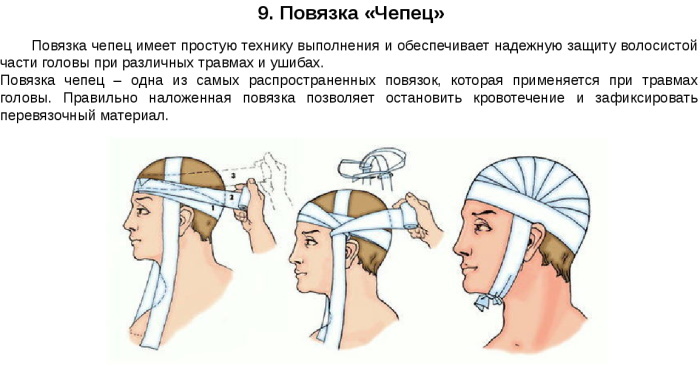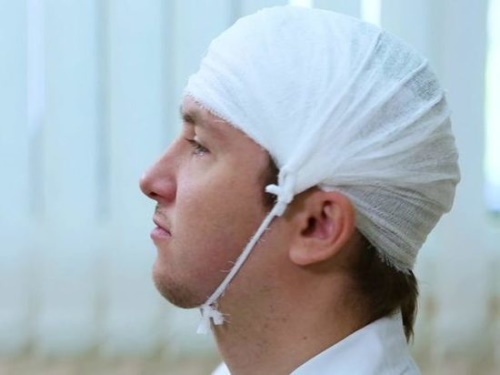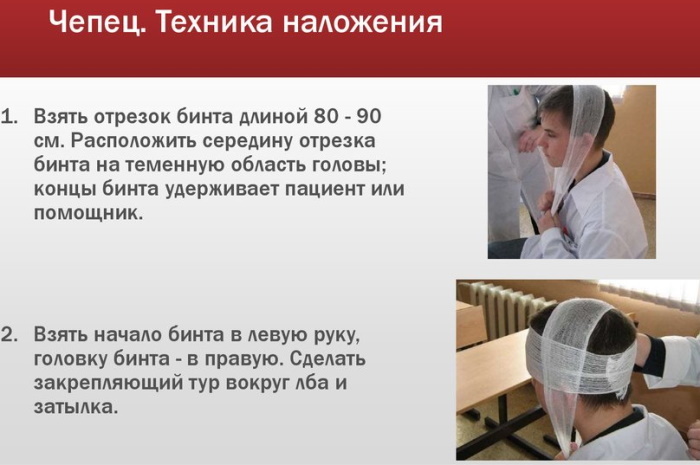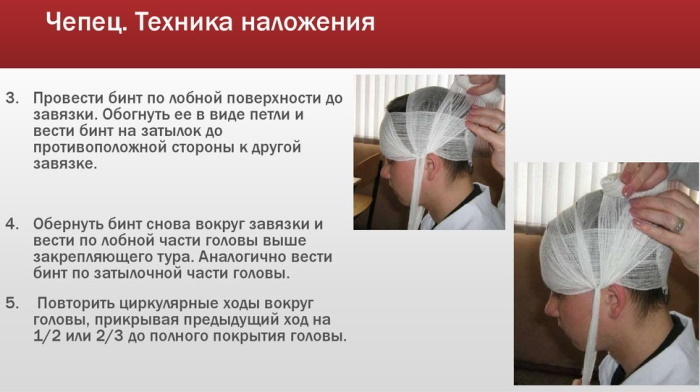Content
- Indications
- Lacerated head wounds
- Stopping bleeding
- Fixation of the dressing
- Burn closure
- Contraindications
- Possible complications
- Training
- Procedure step by step
- General rules for imposing a cap bandage
- Care procedures after
- Advantages and disadvantages
- Video about the bandage cap
The cap bandage is fixed on scalp patients who have injuries to this part of the body. Assessment of the severity of trauma to the skull and soft tissues is carried out before the beginning of the bandaging process with simultaneous antiseptic treatment of the wound surface. The cap is considered one of the most reliable dressings, which has a large number of advantages, but at the same time is not without its disadvantages.
Indications
A cap bandage is applied to the patient's head in an inpatient department of a hospital or in the field, depending on the clinical situation and the patient's underlying disease. In most cases, this method of closing the injured skull tissue acts as one of the forms of first aid.
Lacerated head wounds
The cap dressing is indicated for use in patients with lacerations of the scalp, which were obtained as a result of the following events:
- falling from a height;
- sliding blows on the surface of the head with blunt or sharp objects;
- bites of predatory animals;
- work injuries;
- road traffic accidents.
In this situation, during the application of a sterile dressing of caps, the damaged head tissues are closed from exposure to negative environmental factors in the form of particles of dust, dirt, atmospheric air, pathogenic microorganisms. In the presence of a lacerated head wound, this method of bandaging the skull is only the first stage in a multi-stage process of providing medical care to a patient with severe trauma.
Stopping bleeding
A cap is a headband that is used to quickly stop bleeding. This is another indication for this method of closing the wound surface of soft tissues. For example, the victim may have minor damage to the skin, but with simultaneous injury to the venous vessel.
In this case, the patient needs to quickly stop bleeding with the imposition of a bandage cap, under which is lined with antiseptic material and hemostatic agents that promote clotting blood. Timely thrombosis of the damaged tissue area with their closure from external factors reduces the likelihood of complications, and also speeds up the patient's recovery process.
Fixation of the dressing
The application of a cap bandage on the head is indicated for patients who have undergone surgery on the skull, and throughout the entire period of rehabilitation, they need to regularly receive a high-quality dressing material. These manipulations are performed by specially trained junior medical personnel according to the results morning round of the attending physician with an examination of the condition of patients undergoing inpatient treatment.
In this case, the cap bandage is applied over the consumables in the form of a sterile bandage, on which wound healing, antibacterial and anti-inflammatory agents are applied in the form of solutions, gels, ointments.
Burn closure
The effects of chemical, electrical and thermal burns on the surface of the head can be closed by applying a sterile dressing using the cap-fixing technique. Bandaging of the injured tissue surface is carried out after pretreatment of the burned site with anti-inflammatory and regenerating drugs based on pantothenic compounds acid.
Depending on the severity of the clinical case, drugs of other pharmacological categories can be used. After covering the area of the head with signs of a burn with a sterile cotton bandage with the simultaneous application of medications, a cap bandage is applied. The victim is immediately taken to the hospital of a health care institution, where he receives comprehensive anti-burn treatment.
Contraindications
A cap is a headband that is used for adults and children with signs of damage to the tissues of the skull.
This method of providing first aid has the following contraindications for its use:
- the victim was diagnosed with multiple injuries of the head tissues in the form of lacerations with open bleeding, and the medical worker has only non-sterile bandage (in this case, it is recommended to refrain from using such consumables, covering the wound with only an antiseptic or hemostatic napkin);
- discovered an open craniocerebral injury with crushing of the bones of the skull (the victim should be taken to the emergency room as soon as possible, and prolonged application of a cap dressing can lead to the ingress of bone fragments into the cranial cavity, provoking a deterioration in general well-being patient);
- after the medical worker voiced the patient the actions that will be performed in relation to him the injured part of the head, the victim refused to put a cap bandage on the surface of his cranial boxes.

Closing the damaged areas of the head with a cap bandage has a minimum number of medical contraindications, since this method first aid can prevent a large number of complications associated with the further recovery of the injured fabrics.
Possible complications
Incorrectly performed imposition of a cap dressing on the surface of the patient's cranium, the use of non-sterile consumables, poor preparation of the injured tissues before closing them with a bandage causes the development of the following complications:
- violation of local blood circulation, which can lead to a deterioration in the general well-being of the victim with the appearance of signs of dizziness, impaired coordination of movements, loss of consciousness;
- infection of the injured tissues of the scalp with a bacterial, fungal or viral infection;
- suppuration of the wound surface;
- long-term healing of soft tissues;
- the spread of the infectious and inflammatory process to the cranium with the further development of acute or chronic osteomyelitis;
- infectious blood poisoning;
- inflammation of the brain tissue (for example, if a cap bandage was applied to a patient with an open traumatic brain injury, during the fixation of which the norms of sterility were violated).
In order to prevent the occurrence of complications and other negative consequences caused by fixing the cap dressing, this technique must be strictly observed bandaging the skull, use only high-quality and sterile materials, always perform preliminary antiseptic treatment of the injured fabrics.
Training
Before proceeding with the application of a cap bandage on the surface of the victim's cranium, from a medical worker is required to comply with the following rules of preliminary training:
- The person who provides the victim with first aid, introduces himself to him, is interested in his general well-being, and then announces a plan of action that he takes to close the injured tissue site and stop bleeding.

- Anesthesia is performed on the part of the head that has signs of damage. Local-spectrum injection drugs are used, which are staffed by the ambulance team.
- Measures are being taken to stop bleeding. For the fastest possible localization of blood loss, the method of applying hemostatic wipes is used. Consumables of this type contain drugs that accelerate the process of blood thrombosis. The hemostatic napkin is kept on the wound surface for 3-5 minutes. depending on the intensity of bleeding.
- The skin surface around the wound is cleaned. Apply sterile antiseptic wipes, iodine solution of 2% concentration. During the toilet of tissues located in the circumference of the injured area of the head, particles of dirt and debris that have got on the skin at the time of its injury are removed.
- An aseptic napkin is applied over the wound surface to prevent infection of the wound by pathogens.
- The medical worker takes sterile bandages and scissors from the suitcase for manipulation, aimed at providing the victim with first aid with imposition on the surface of the head bandage caps.
Throughout the entire period of bandaging the cranium, the injured must remain physically calm, be at the maximum comfortable position for yourself, but at the same time follow all the instructions of the doctor, in terms of changing the position for more convenient application of the fixing bandages.
Procedure step by step
A cap is a bandage on the head, the imposition of which takes place in compliance with the established algorithm of actions. The table below describes in detail the step-by-step procedure for fixing this type of dressing on the surface of the patient's head.
| Algorithm for imposing a bandage cap | Description of the actions of the medical worker |
| Step 1. Preparing consumables | The healthcare professional should prepare a medium-width cut of sterile bandage with a strip length of 80 to 90 cm. This amount of dressing material is sufficient to cover the skull of an average adult. |
| Step 2. Bandage application | The specified cut of the sterile bandage is placed on the surface of the parietal region of the patient's head so that the ends of the dressing hang down vertically in front of the patient's ears. Tighten these edges of the consumable with your fingers. |
| Step 3. Execution of circular moves. | Holding the pieces of gauze bandage hanging in front of the auricles, 2 to 3 circulatory passages are performed around the patient's cranium. Bandaging is carried out only with a single piece of gauze fabric. |
| Step 4. Carrying out consumables along the frontal lobe of the head | A sterile bandage is applied along the surface of the frontal lobe of the head up to the tie. At this point in the application of the cap dressing, it is very important to ensure that sufficient tension is maintained in the dressing, but that there is no excessive compression of the blood vessels. |
| Step 5. Overtaking a loop-shaped bandage | From the frontal lobe of the head, the bandage is overtaken along the surface of the skull in the form of a loop, and then is led to the back of the head towards the opposite side, where the other tie is located. |
| Step 6. Redirecting the bandage to the frontal lobe of the head | You will need to overtake the loop bandage and then redirect the dressing back to the surface of the frontal lobe of the head. |
| Step 7. Repeating circular moves | The repeated application of circulatory passages with a sterile bandage around the patient's head continues. Each next skein overlaps the previous dressing by 50 or 60%, depending on the area of the wound surface and the severity of tissue damage. The application of the next circulatory passages continues until the entire cranium of the patient is covered with a soft bandage of the cap. |
| Step 8. Strengthening the bandage | The procedure for strengthening the performed bandage is carried out using 1-2 circulatory strokes, which are applied around the head with the further formation of a strong knot based on one of the edges of the band. |
| Step 9. Tying the edges of the tie | The other end of the bandage is tied to the adjacent end of the bandage under the patient's chin. Ultimately, a soft cap of a sterile bandage forms on the surface of the patient's head, which covers the entire surface of the cranium. |

 Upon completion of the above manipulations, the medical worker must inform the victim that he is now will be taken to the inpatient department of the hospital, where he will be examined with the appointment of further treatment.
Upon completion of the above manipulations, the medical worker must inform the victim that he is now will be taken to the inpatient department of the hospital, where he will be examined with the appointment of further treatment.
General rules for imposing a cap bandage
The fixation of a soft bandage bandage cap must be carried out with the obligatory observance of the following rules:
- The bandaged head of the injured person should be at the level of the chest of the person providing medical assistance.
- Before starting the application of the fixing bandage, the patient takes a comfortable position for himself, which does not contribute to the deterioration of his general well-being.
- The bandaged surface of the head must remain motionless. Otherwise, the soft bandage may shift or its loose fit to the surface of the head.
- The medical professional who applies the bandage of the cap should stand so that he can see the bandaged tissue at all times, as well as the face of the injured person.
- The bandaging process occurs with the movement of consumables from the periphery towards the center.
- The head of a skein with a sterile bandage is always taken in the right hand, and its edges in the left limb.
- It is strictly forbidden to pre-unwind the coil with a sterile dressing bandage, since these actions are a direct violation of sterility standards.
- The reinforcing circular tour is the primary actions of the medical professional, with which the bandaging process begins.
- A roll of sterile bandage rolls over the surface of the victim's head without breaking away from the surface of the head with uniform tension.
- Each round of bandage dressing should overlap the previous one by 50% of its area.
- Bends must be made on the tapered sections of the dressing.
- In the process of bandaging the head using the cap technique, one should refrain from returning movements.
- The applied bandage must fully fulfill its function, not cause a feeling of pain, discomfort, and also cannot cause a violation of local blood circulation. In the presence of such symptoms, there is a high probability that mistakes were made during the head bandage.
Correctly applied bandage cap has an aesthetic appearance, is tightly fixed to the surface of the injured person's skin, does not have distortions and other defects.
Care procedures after
A cap is a headband that requires daily care to prevent the development of complications.
In this case, you will need to comply with the following rules:
- Change the dressing caps daily, removing the old bandages and applying a new layer of sterile dressing material. This procedure should be carried out at the same time of day after a preliminary examination of the wound surface of the head by the attending physician.
- Antiseptic treatment of injured tissues is carried out before the planned replacement of the dressing. If it is a lacerated wound, then it must be disinfected with an antiseptic drug. Hydrogen peroxide, or other solutions with antibacterial properties that have been prescribed doctor.
- The treatment of epithelial tissues located in the circumference of the wound at a distance of 5-8 cm is mandatory. On these areas of the skin, a solution of Iodine of 2% concentration or Diamond Green is applied.
- A cap bandage that has become soaked in ichor, pus or a lot of blood due to the fact that it closes a weeping, long-lasting wound, must be replaced early. In this case, the planned change of the dressing material is performed 2 times a day, and the surface of the injured tissues processed with medicinal preparations with drying, wound healing, hemostatic and antibacterial properties.
Patients undergoing treatment in the inpatient department of the hospital receive daily care at the treatment facility at the place of therapy. Patients with mild head injuries come for head bandages to the surgeon's office at their place of residence. In this case, the treatment is carried out on an outpatient basis, and the dressing of the cap is taken care of by the nurse who is responsible for removing and reapplying the dressing.
Advantages and disadvantages
Covering the injured head with a cap bandage has the following therapeutic benefits:
- isolation of the wound surface from the negative effects of pathogens;
- prevention of an infectious and inflammatory process, which can occur due to the ingress of particles of dirt, dust into an open wound of the head;

- maintaining the sterility of the injured skin area;
- the versatility of the soft cap bandage;
- the ability to close the entire surface of the cranium, which is very convenient for the treatment of head wounds with a large area of damage;
- under the cap bandage, you can put an antiseptic, hemostatic napkin or a piece of sterile gauze cloth, soaked in a medicinal product (for example, with a wound healing or antibacterial ointment, solution, gel).
The disadvantages of a cap bandage include the following risks associated with its application to the surface of the head:
- fixation of the dressing using this technique of closing the skull requires certain knowledge, skills and practical experience from the medical professional;
- weak tension on the edges of the bandage can lead to the fact that the bandage will not fit snugly to the surface head, will shift, or it will cease to perform its function of closing the wound from the influence of external Wednesday;
- in case of untimely replacement of the cap dressing, an infectious and inflammatory process with bacterial damage to the injured tissues may begin under its surface;
- too tight fixation of the edges of the bandage causes a violation of local blood circulation, which is accompanied by dizziness, darkening of the eyes, headache attacks with physical weakness.
Correct application of the cap bandage accelerates the patient's recovery time with complete healing of head wounds without complications. This method of closing the injured areas of the skull has many more advantages than disadvantages.
A cap bandage is a kind of bandage technique for damaged head tissues, it is used to provide emergency medical help for patients with severe cranial trauma, and is also used in relation to patients who have undergone surgery brain.
Before applying the dressing, the epithelial tissues are pretreated with antiseptic and anesthetic agents. If there are signs of severe bleeding, the healthcare professional applies a hemostatic wipe or uses other hemostatic medications. After treating the wound with drugs, the head is bandaged with a cap bandage.
Video about the bandage cap
First aid. Applying a bandage cap:
